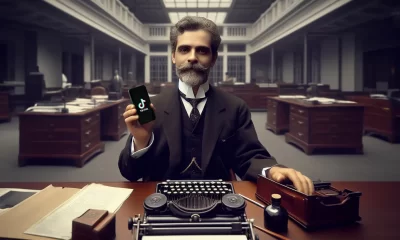5 Reasons Why Storytelling in Communication is Essential for Engaging Audiences

2. Set the Scene
Give your audience a sense of place and context. Describe where the story is happening and the circumstances surrounding it. This helps your audience visualize the story and become more immersed in it.
3. Introduce a Challenge
Every story needs a challenge or problem to overcome. This is where you highlight the obstacles or pain points that resonate with your audience. It’s what keeps them engaged and invested in the outcome.
4. Offer a Resolution
Your story should offer a solution or insight that addresses the challenge. This is where you deliver your message or lesson, showing how the character overcame the challenge. It’s the part of the story that leaves a lasting impression.
5. End with a Call to Action
After telling your story, guide your audience on what to do next. Whether it’s making a decision, trying a new approach, or simply thinking differently, a clear call to action makes your story more effective.
By incorporating these elements into your communication, you can make your stories more compelling and memorable.
Real-Life Examples of Storytelling in Action
To see storytelling in communication at work, look no further than successful brands and leaders who have mastered the art of narrative.
1. Apple’s Brand Story
Apple doesn’t just sell products; it tells a story of innovation, creativity, and breaking the mold. Through their marketing, they create a narrative that makes customers feel like they’re part of something bigger than just buying a gadget—they’re joining a movement.
2. TED Talks
TED speakers are known for their ability to captivate audiences with compelling stories. They don’t just present data or ideas; they weave them into narratives that resonate on a personal level. This storytelling approach is what makes TED Talks so memorable and widely shared.
3. Nonprofits and Advocacy Campaigns
Nonprofits often use storytelling to highlight the impact of their work. By sharing real-life stories of people who have been helped by their efforts, they create an emotional connection that inspires donations and support.
These examples show how storytelling in communication can be used to engage audiences, convey messages, and drive action across different fields.
Recommended Reading: Books on Storytelling and Communication
If you’re eager to dive deeper into the world of storytelling in communication, here are some books that offer valuable insights and practical tips:
1. Made to Stick by Chip Heath & Dan Heath
- This book explores why some ideas stick and others don’t, with a strong focus on the power of storytelling. The Heath brothers provide a framework for creating messages that are memorable and impactful.
2. The Storyteller’s Secret by Carmine Gallo
- Carmine Gallo delves into the secrets of the world’s most inspiring communicators, showing how they use storytelling to connect with their audiences. This book is full of real-world examples and practical advice.
3. Building a StoryBrand by Donald Miller
- Donald Miller offers a guide to using storytelling to clarify your message and connect with customers. His StoryBrand framework has helped countless businesses sharpen their communication and grow their brands.
4. Resonate by Nancy Duarte
- Nancy Duarte’s book is a must-read for anyone looking to make their presentations more engaging. She explains how to use storytelling techniques to create presentations that resonate with audiences.
5. The Hero with a Thousand Faces by Joseph Campbell
- While not specifically about business communication, this classic work on mythology explores the universal patterns in storytelling. Understanding these archetypes can help you craft narratives that connect on a deeper level.
These books provide a deeper understanding of how to effectively use storytelling in communication to engage and inspire your audience.
Conclusion
Storytelling in communication isn’t just a trend—it’s a powerful tool that can transform how you connect with your audience. By tapping into the natural human affinity for stories, you can make your messages more engaging, memorable, and impactful.
So, what’s your story?
Whether you’re leading a team, marketing a product, or simply sharing an idea, start incorporating storytelling into your communication strategy.
Remember, the key to powerful communication isn’t just in what you say—it’s in how you say it. Embrace storytelling and watch your ability to connect with others soar.
Finding Balance: The Art of Saying No Without Guilt

Have you ever felt overwhelmed because you said “yes” to something you really didn’t want to do? Saying no without guilt can be tough, and it happens to the best of us.
Sometimes, we find ourselves agreeing to things out of fear—fear of letting someone down, of missing out, or of being seen as selfish. But what if learning to say “no” could actually be one of the most powerful things you do for yourself?
Table of Contents
The Weight of the Word “Yes”
It all starts with a simple word: “yes.” It’s such a small word, yet it can carry so much weight. I remember a time when I was saying “yes” to everyone—my friends, my family, my coworkers.
Every time someone needed a hand, I was there, ready and willing, even if it meant staying up late, giving up my weekends, or putting aside my own needs.
It seemed like I was being helpful, but in truth, I was crumbling under the pressure.
I realized I was losing myself under the pile of promises I had made to others. I would go to bed exhausted, feeling like I hadn’t done a single thing for myself.
Slowly but surely, I understood that my problem wasn’t just time—it was boundaries. I needed to learn the art of saying “no” without carrying the crushing weight of guilt.
The Guilt Trap: Why Is Saying No without guilt is So Hard?
Saying “no” can feel like you’re letting someone down. And isn’t that the worst feeling? It’s like telling a friend that you can’t help them move or turning down extra work from a boss who trusts you.
It feels selfish, like you’re closing a door on someone who’s counting on you.
But here’s the thing: every time you say “yes” to something you don’t want, you’re actually saying “no” to yourself. You’re saying “no” to your rest, to your hobbies, to the quiet moments you need just to be.
And when you keep putting yourself last, you start to feel that gnawing sense of frustration and burnout—because, deep down, you know you deserve better.
“Saying ‘no’ isn’t about pushing people away. It’s about creating space for what truly matters, for both you and the people who need you most.”
The Power of a Well-Placed “No”
There’s power in the word “no.” It’s not just a rejection—it’s a redirection. It’s telling the world that your time and energy are precious, and that you know exactly where you want to focus them.
Saying “no” can be freeing. It can be an act of courage, a promise to yourself that your needs matter just as much as anyone else’s.
I remember the first time I said “no” to a big request. A friend had asked me to help plan a huge event—a project that would take weeks of my evenings and weekends. I almost said yes out of habit, but I caught myself.
I realized that I needed this time for me. I politely told my friend that I couldn’t commit this time, and, to my surprise, she understood. She even thanked me for being honest. It felt like a weight lifted from my shoulders.
“No” doesn’t have to be harsh. It can be gentle, kind, and full of respect—both for yourself and for others.
How to Say “No” Without the Guilt
Learning to say “no” takes practice. It’s not about being rude or uncaring, but about setting healthy boundaries. Here are some ways you can say “no” while still feeling good about it:
- Be Honest, But Kind: You can say, “I wish I could help, but I just don’t have the time right now.” This shows you care, but you also have limits.
- Offer an Alternative: If you can’t say yes, offer another way to help, like suggesting someone else who might be available or offering to help at a different time.
- Keep It Simple: You don’t have to explain everything. A simple “No, I can’t take that on right now” can be enough. The more you justify, the harder it becomes.
- Remember Your Priorities: Ask yourself, “If I say yes, what am I saying no to?” Keeping your own needs and goals in mind can make it easier to decide.
Setting Boundaries Is Self-Care
When you say “no,” you’re not only protecting your time; you’re also setting an example for others. You’re showing them that it’s okay to put yourself first sometimes.
This kind of self-care is like building a wall—not to keep people out, but to make sure that what comes in is what you truly want.
Think of it like a garden. You need boundaries to keep out the weeds so that the flowers—the things that bring you joy—can grow. If you let everyone trample through it, eventually, the flowers will wither, and you’ll be left with a patch of dirt. Boundaries allow you to nurture the beauty in your life.
“Boundaries aren’t walls; they are gates that let the right things in and keep the harmful things out.”
Conclusion: Finding Balance in Life
So, the next time someone asks you for something, take a moment. Don’t rush into a “yes” out of habit or guilt. Pause and ask yourself if this is something you can and want to do.
Remember, saying “no” doesn’t make you a bad person. It makes you someone who knows the value of their time, energy, and well-being.
Now, I’d love to hear from you. What’s one thing you wish you could say “no” to more often? Let’s start practicing together. You deserve the peace that comes from creating healthy boundaries—one “no” at a time.
Millennials vs. Gen Z: 11 Simple Ways to Show Appreciation

Why Showing Appreciation Matters Across Generations
No matter your age, feeling appreciated is like a warm hug—it just feels good. Whether you’re a Millennial juggling work and family or a Gen Z navigating school and social media, finding simple ways to show appreciation can strengthen your connection with others.
It’s not about grand gestures, but rather small, meaningful actions that let people know you value them. Taking a moment out of your day to express gratitude, whether through a thoughtful message or spending quality time, can make all the difference in building and nurturing relationships.
“Appreciation is the foundation of any lasting relationship, no matter the generation.” – Dr. Emily Roth, Relationship Expert
Both Millennials and Gen Z value appreciation, but how they give and receive it can differ. Millennials tend to appreciate personal, face-to-face interactions. Gen Z, on the other hand, often turns to digital platforms to show their gratitude.
So while the methods to show appreciation might differ, the core message stays the same: it’s all about making the other person feel valued.
11 Simple Ways to Show Appreciation to Your Loved Ones
“The act of expressing gratitude, no matter how small, strengthens bonds and builds trust.” – John Howard, Relationship Coach
1. Write a Heartfelt Note
Millennials might remember the days of handwritten notes—folded neatly and tucked into a friend’s locker. They love putting pen to paper to express their gratitude. A handwritten letter can feel personal, thoughtful, and long-lasting.
Gen Z, however, often prefers a digital touch. A sweet, well-written text message or a beautifully crafted Instagram post might be their go-to. The platform might change, but the heart behind the appreciation remains the same.
2. Give Them Your Undivided Attention
“In today’s fast-paced world, offering your full attention is one of the most sincere gifts you can give.” – Psychology Today
Sometimes, showing appreciation means just being present. Millennials might put their phones away during dinner, offering undivided attention as a way to show they care.
Gen Z might express appreciation through digital means—like sharing a video chat or sending a specially curated playlist. The key is giving time and focus, whether in person or online.
3. Surprise Them with a Thoughtful Gift
When it comes to gifts, Millennials tend to favor artisanal, nostalgic items like a personalized mug or vintage records that evoke memories.
Gen Z is more likely to go for trendy, modern items, like limited-edition sneakers or a digital subscription to their favorite app. For both generations, the key is picking something that shows you’ve been paying attention to what makes the other person smile.
“The best gifts don’t have to be expensive—they just need to show you care.” – Erica James, Gift Giving Expert
4. Cook Their Favorite Meal
Millennials often show appreciation by cooking their loved one’s favorite meal. A homemade lasagna or perfectly grilled steak can speak volumes without saying a word.
On the other hand, Gen Z might opt to order their loved one’s favorite takeout or send a food delivery. It’s still about knowing what they love and making sure they enjoy it, no matter how it arrives.
5. Give a Compliment
A well-placed compliment can brighten anyone’s day. Millennials often offer verbal praise like, “You did an amazing job!” or “That looks great on you!” They value face-to-face expressions of appreciation.
Gen Z, however, may post a shout-out on social media or drop a fire emoji under a picture to show they’re paying attention. Different delivery, same impact.
6. Help Them with Something They’ve Been Putting Off
“Acts of service can be one of the strongest demonstrations of love.” – Gary Chapman, Author of The 5 Love Languages
Sometimes, the best way to show appreciation is by offering help. Millennials might offer hands-on assistance, like helping you move or clean the garage.
Gen Z might offer remote help—organizing files on Google Drive or whipping up a shared doc for collaboration. Both generations show they care by making your life a little easier.
7 Reasons Why Random Acts of Kindness Are More Powerful Than You Think

Have you ever held the door open for a stranger or offered a compliment, only to find it brightened your day just as much as theirs?
These simple gestures are what we call random acts of kindness, and they’re becoming more popular as people realize just how impactful they can be.
In a world where negativity often grabs the headlines, these small acts of kindness can create a ripple effect of positivity.
Whether it’s paying for someone’s coffee or simply sharing a smile, these gestures don’t just benefit the receiver—they also uplift the giver.
Let’s explore why random acts of kindness are more powerful than you might think, and how you can easily incorporate them into your daily life.
Table of Contents
The Psychology Behind Kindness: Why It Feels So Good
Ever wondered why performing random acts of kindness feels so good? It turns out, there’s some fascinating psychology behind it.
When you do something kind, your brain releases a cocktail of feel-good chemicals, including serotonin, oxytocin, and endorphins.
Serotonin is often referred to as the “happy hormone,” and it plays a crucial role in boosting your mood. When you perform an act of kindness, your brain produces more serotonin, making you feel more content and fulfilled.
Oxytocin, sometimes called the “love hormone,” is released when you connect with others through kind actions. It fosters a sense of bonding and trust, which can strengthen relationships and build a sense of community.
And let’s not forget about endorphins, the body’s natural painkillers. These chemicals are released during acts of kindness, leading to what’s often called a “helper’s high”—a rush of happiness that makes you want to keep spreading positivity.
By performing random acts of kindness, you’re not just making someone else’s day brighter; you’re also enhancing your own well-being in a meaningful way.
The Ripple Effect: How Kindness Spreads
One of the most incredible aspects of random acts of kindness is their ability to spread far beyond the initial gesture.
When you do something kind, it often inspires the recipient to pass it on, creating a chain reaction that can ripple through communities and even across the world.
Imagine you start your day by buying a coffee for the person behind you in line. That small act could inspire them to hold the door open for someone else, who might then go on to help a colleague at work.
Before you know it, your single act of kindness has sparked a series of positive actions.
This ripple effect isn’t just hypothetical—it’s backed by research. Studies have shown that when people witness or experience kindness, they’re more likely to engage in kind behaviors themselves. This means that your small gesture can lead to a much larger impact than you might expect.
In workplaces, communities, and even online, random acts of kindness can create an environment where positivity thrives. It’s a powerful reminder that even the smallest actions can have a profound effect.
Building Resilient Relationships: Strengthening Bonds in Challenging Times

Introduction
When life gets tough, holding onto what really matters becomes our lifeline. Resilience in relationships is more important than ever.
With the world full of uncertainties and challenges, couples are being tested in ways they never expected.
But here’s the silver lining: building resilient relationships isn’t just about getting through the storm; it’s about coming out stronger on the other side.
Whether it’s dealing with a pandemic, facing financial hardships, or navigating everyday ups and downs, the bond between two people can become a fortress.
In this article, we’ll explore how couples can strengthen their connection during tough times.
We’ll dive into how communication fosters resilience and share some practical relationship resilience strategies to help you stay strong, no matter what life throws your way.
Table of Contents
The Importance of Resilience in Relationships
Think of resilience in relationships like the roots of a sturdy tree. When storms come, it’s those deep roots that keep the tree standing tall.
In the same way, resilience keeps your relationship grounded, even when life gets rough.
Global challenges—like pandemics, financial stress, or other crises—are like fierce winds testing your bond. Without resilience, these challenges can tear you apart.
But with resilience, they can pull you closer, turning tough times into opportunities for growth.
Building resilient relationships means being adaptable, leaning on each other, and finding new ways to stay connected. It’s understanding that life isn’t always smooth, but together, you can weather any storm.
Strengthening Bonds During Crises
When the world feels heavy, it’s easy to feel overwhelmed. But crises can also be a time to draw closer to your partner, to find comfort in each other’s presence. This is where building resilient relationships really shines.
One powerful way to strengthen your bond is through shared activities. Whether it’s cooking a meal together, taking a walk, or just sitting down for a heart-to-heart, these moments create a sense of normalcy and connection.
Trust and shared values also play a huge role in relationship resilience strategies. When you trust each other and share common goals, facing challenges together feels easier.
You’re not just two people—you’re a team, stronger together than apart.
And let’s not forget about laughter. Even in the darkest times, finding reasons to smile can be a lifeline. These small, joyful moments keep the flame of your relationship burning bright.
The Role of Communication in Fostering Resilience
If resilience is the roots of the tree, communication is the water that nourishes them. Without clear and open communication, resilience in relationships can wither.
During tough times, it’s easy to let stress take over, leading to misunderstandings or arguments. But this is when communication becomes more important than ever.
It’s about being open, honest, and, most importantly, listening to each other.
One of the best relationship resilience strategies is to check in with each other regularly. Ask how your partner is feeling, and really listen.
Sometimes, just knowing that someone is there to listen can make all the difference.
Remember, communication isn’t just about words. It’s also about body language, tone, and even silence. Sometimes, a comforting touch or a shared look can speak volumes.
Strategies for Maintaining Connection and Support
Staying connected during difficult times takes effort, but it’s worth it. These relationship resilience strategies can help you maintain that all-important connection.

First, make time for each other. In the chaos of life, it’s easy to put your relationship on the back burner. But setting aside time to connect, even if it’s just a few minutes a day, can make a big difference.
Next, practice empathy. Try to see things from your partner’s perspective, especially when they’re struggling. Understanding their feelings and offering support can strengthen your bond.
Finally, keep the lines of communication open. Regular check-ins, whether they’re serious talks or light-hearted chats, help maintain the connection. It’s about keeping the bridge between you strong, no matter what’s happening in the world around you.
Conclusion
Building resilient relationships isn’t something you do once and forget about. It’s an ongoing journey. It’s about finding strength in each other and in the love you share.
With the right relationship resilience strategies, you can weather any storm together.
So take the time to invest in your relationship. Talk, listen, support each other, and don’t forget to find joy in the little things. Together, you can build a relationship that not only survives but thrives, no matter what challenges come your way.
-

 Personal Growth & Mindset5 months ago
Personal Growth & Mindset5 months agoTed Lasso Effect: 5 Goal-Setting Secrets You Must Know
-

 AI & Future Trends10 months ago
AI & Future Trends10 months agoAI in Time Management 2024: A New Era of Productivity for Business Leaders
-

 Personal Growth & Mindset6 months ago
Personal Growth & Mindset6 months agoMachado de Assis: This Viral TikTok Explains Why You Need to Read ‘The Posthumous Memoirs of Brás Cubas’ Now
-

 Career & Success11 months ago
Career & Success11 months ago30 Key Strategies for Growth: Mindset, Productivity & Wellness
-

 Career & Success6 months ago
Career & Success6 months agoChallenges of Not Having Goals: 5 tips to help you get started
-

 Personal Growth & Mindset11 months ago
Personal Growth & Mindset11 months agoBreaking Free from the Shackles of Bad Habits: 5 books to help you



































Pingback: 12 Habits of Successful People You Can Start Today | Growth Journey Hub